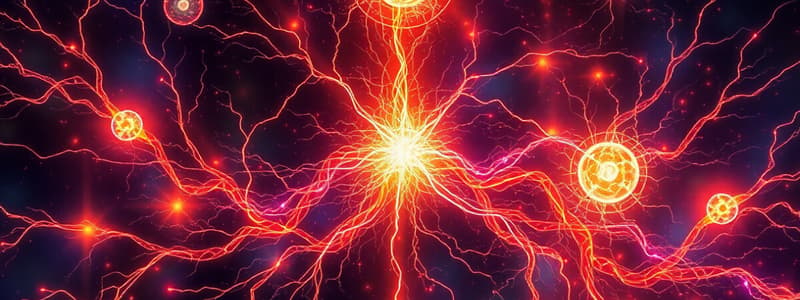Podcast
Questions and Answers
What is meant by charging by conduction?
What is meant by charging by conduction?
- Charging due to temperature differences between objects
- Charging without physical contact between objects
- Charging caused by external electrical fields
- Charging through direct physical contact between objects (correct)
What happens to the total negative charge during conduction?
What happens to the total negative charge during conduction?
- It decreases significantly.
- It completely transfers to one object.
- It remains constant overall. (correct)
- It increases exponentially.
What role does a grounding wire play in charging by induction?
What role does a grounding wire play in charging by induction?
- It allows electrons to travel between the object and the ground. (correct)
- It amplifies the electric charge of the object.
- It acts as insulator to prohibit charge transfer.
- It absorbs excess charge to neutralize the object.
What is a key difference between conductors and insulators during the charging process?
What is a key difference between conductors and insulators during the charging process?
What typically happens when a positively charged object touches a neutral conductor?
What typically happens when a positively charged object touches a neutral conductor?
What is the primary function of myelin sheaths in neurons?
What is the primary function of myelin sheaths in neurons?
What are the Nodes of Ranvier responsible for in a myelinated axon?
What are the Nodes of Ranvier responsible for in a myelinated axon?
What is the maximum speed of action potentials in a myelinated axon?
What is the maximum speed of action potentials in a myelinated axon?
Which of the following describes demyelination?
Which of the following describes demyelination?
What happens to action potential conduction in unmyelinated axons compared to myelinated axons?
What happens to action potential conduction in unmyelinated axons compared to myelinated axons?
What physiological change occurs during depolarization of a neuron?
What physiological change occurs during depolarization of a neuron?
What is the cause of multiple sclerosis?
What is the cause of multiple sclerosis?
At rest, what is the charge difference across a neuron membrane known as?
At rest, what is the charge difference across a neuron membrane known as?
What happens to total resistance when resistors are added in series?
What happens to total resistance when resistors are added in series?
What is the correct equation to calculate the total resistance of two resistors in parallel?
What is the correct equation to calculate the total resistance of two resistors in parallel?
Which statement correctly describes an ohmic conductor?
Which statement correctly describes an ohmic conductor?
When two different materials are rubbed together, what happens to the electrons?
When two different materials are rubbed together, what happens to the electrons?
What does the potential difference (p.d.) measure?
What does the potential difference (p.d.) measure?
What characterizes components connected in parallel?
What characterizes components connected in parallel?
In the context of charging by friction, which material would likely lose electrons?
In the context of charging by friction, which material would likely lose electrons?
If a particle has a net charge of 3e, what is the total charge in coulombs?
If a particle has a net charge of 3e, what is the total charge in coulombs?
Flashcards
Charging by Conduction
Charging by Conduction
Charging an object by direct contact with another charged object, allowing charges to transfer between them.
Conductor
Conductor
A material that allows charges to flow freely through it. Examples include metals.
Insulator
Insulator
A material that resists the flow of charges. Examples include glass and rubber.
Charging by Induction
Charging by Induction
Signup and view all the flashcards
Grounding Wire
Grounding Wire
Signup and view all the flashcards
Saltatory Conduction
Saltatory Conduction
Signup and view all the flashcards
Myelin Sheath
Myelin Sheath
Signup and view all the flashcards
Nodes of Ranvier
Nodes of Ranvier
Signup and view all the flashcards
Demyelination
Demyelination
Signup and view all the flashcards
Depolarization
Depolarization
Signup and view all the flashcards
Potential Difference
Potential Difference
Signup and view all the flashcards
Hyperpolarization
Hyperpolarization
Signup and view all the flashcards
Schwann Cells
Schwann Cells
Signup and view all the flashcards
Depolarization and Hyperpolarization
Depolarization and Hyperpolarization
Signup and view all the flashcards
Coulomb (C)
Coulomb (C)
Signup and view all the flashcards
Elementary charge (e)
Elementary charge (e)
Signup and view all the flashcards
Quantization of Charge
Quantization of Charge
Signup and view all the flashcards
Conventional Current
Conventional Current
Signup and view all the flashcards
Electron Flow
Electron Flow
Signup and view all the flashcards
Potential Difference (p.d.)
Potential Difference (p.d.)
Signup and view all the flashcards
Ohmic Conductor
Ohmic Conductor
Signup and view all the flashcards
Study Notes
Electrolysis
- Electrolyte: A substance that conducts electricity when dissolved in a liquid or melted.
- Electrolysis: The process of using an electric current to drive a non-spontaneous chemical reaction.
- Ion Movement during Electrolysis: Cations (positive ions) move towards the cathode (negatively charged electrode), and anions (negative ions) move towards the anode (positively charged electrode).
- Oxidation and Reduction: Oxidation is the loss of electrons, while reduction is the gain of electrons.
- Electrodes: Oxidation occurs at the anode, reduction occurs at the cathode.
The Nervous System
- Nervous System Parts: Sensory neurons, motor neurons, relay neurons, brain, spinal cord.
- Sensory Stimulus Detection: Sensory receptors detect stimuli, generating nerve impulses.
- Sensory Neuron Structure: Sensory neurons have a long axon for rapid signal transmission and specialized receptors.
- Impulses to/from Brain: Impulses travel along sensory neurons to the spinal cord or brain, processed, and then travel back as commands to motor neurons.
- Sensory Neuron Adaptation: Myelin sheath insulates the axon, increasing impulse speed.
- Motor Neuron Response: The nervous system responds to stimuli through motor neurons, relaying messages for reactions.
- Motor Neuron Structure: Motor neurons have a long axon to transmit signals to muscles or glands, and a short dendrite.
- Motor Neuron Adaptations: Myelin sheath increases impulse speed; branching axons ensure multiple muscle fibers receive signals simultaneously.
- Relay Neuron Function: Relay neurons connect sensory and motor neurons, necessary for complex reactions within the nervous system.
- Synapse Action: Synapses are specialized junctions between neurons. Release of neurotransmitters transmits signals across the synapse.
- Reflex Arc: A faster response loop, with less involvement of the brain.
- Reflex Arc Function: Sensory receptors trigger rapid responses to stimuli.
- Saltatory Conduction: The process of nerve impulse propagation on myelinated axons where the signal "jumps" between nodes of Ranvier.
Electricity
- Potential Difference: The difference in electric potential between two points of a circuit.
- Coulomb: The SI unit of electric charge.
- Elementary Charge: The fundamental unit of electric charge, 1.6 × 10⁻¹⁹ C
- Quantized Charge: Charge is a multiple of elementary charge.
- Conventional Current: Current flowing from positive to negative, or opposite to electron flow.
- Types of Electrical Charge: Positive and negative charges.
Charging by Friction, Conduction and Induction
- Charging by Friction: Transferring electrons between materials by rubbing them together. Materials with significantly different electron binding strengths can develop an imbalance.
- Charging by Conduction: Transferring electrons by direct contact between materials. A charged object that contacts an uncharged object causes the same charge to be distributed to the uncharged one.
- Charging by Induction: Producing a charge in a neutral object by bringing a charged object in close proximity without touching it. Transfer of charge occurs from one conductor to another, through a medium like the ground.
Studying That Suits You
Use AI to generate personalized quizzes and flashcards to suit your learning preferences.





